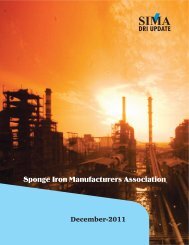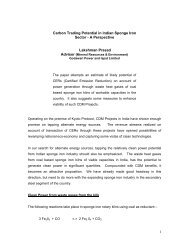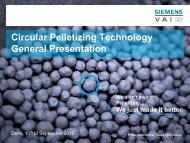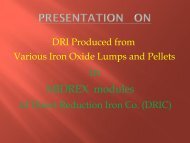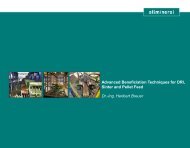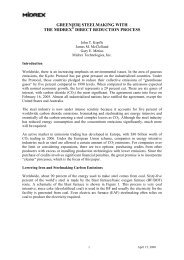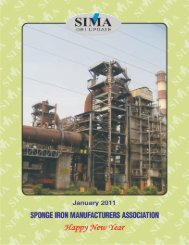Create successful ePaper yourself
Turn your PDF publications into a flip-book with our unique Google optimized e-Paper software.
TENOVA HYL CONTINUES EMPHASIS ON ENVIRONMENTAL IRON &<br />
STEEL MAKING WITH ENERGIRON TECHNOLOGY<br />
The first industrial scale direct reduction plant back<br />
in the mid 1950’s was a success on a number of<br />
fronts for HYL. The purpose of providing a quality<br />
pure iron feedstock for electric furnace steel<br />
making was achieved, and step by step a growing<br />
use and acceptance developed for the product,<br />
which led to today’s burgeoning DRI industry<br />
worldwide.<br />
When the 1M Hylsa DR plant in Monterrey, Mexico<br />
was put into operation, the environment was not<br />
a major consideration. The 1950’s was an era of<br />
increased industrialization worldwide following<br />
WWII and little attention was paid at the time to<br />
the ecological effects of industrial growth. The<br />
plant consumed over 4 times the natural gas that<br />
today’s process requires, and since it was a batch<br />
process in open retorts, particulate matter and<br />
gaseous pollution were obvious side-effects of the<br />
technology.<br />
Fortunately, those days have long passed and<br />
today’s technology from Tenova HYL is green and<br />
streamlined. The process is now being marketed<br />
and developed jointly with Danieli & C. under the<br />
new Energiron trademark. Not only is the process<br />
itself the most environmentally friendly, but new<br />
collateral technologies such as the HYL HYTEMP<br />
System have made steel making more efficient<br />
and clean by transporting the DRI hot in a fully<br />
enclosed pneumatic system to modern electric<br />
furnaces. An added advantage of these<br />
technologies is that they are also more efficient<br />
and more cost-effective than ever.<br />
Reducing Gases<br />
In an Energiron plant the reducing gas is produced<br />
in two ways: in an external steam reformer, and/<br />
or directly in the shaft reactor by means of “in<br />
situ reforming” reactions.<br />
The ratio between reforming and “in situ<br />
reforming” can be varied to balance production<br />
Thomas Scarnati<br />
Manager- Marketing & Sales<br />
HYL Technologies, SA.De C.V, Mexico<br />
and investment costs exigencies. The Energiron<br />
scheme can be based on 100% external reforming<br />
to 100% “in-situ” reforming (ZR) or any<br />
combination (small reformer + oxygen injection).<br />
This is a unique characteristic of the Energiron<br />
process flexibility. The most adequate scheme will<br />
depend on the local cost structure of energy and<br />
raw materials. As an example, the scheme with<br />
external reformer consumes more gas, but the<br />
power is minimized, while the ZR scheme minimizes<br />
the natural gas consumption but requires more<br />
power (electricity + oxygen). Also, the product<br />
quality has to be considered: the scheme with<br />
100% external reforming produces DRI with up to<br />
2.4% carbon or up to 3.5% carbon if there is some<br />
oxygen injection, while the ZR produces DRI with<br />
= 4% carbon. The most adequate scheme must<br />
be selected based upon the production cost<br />
analysis up to liquid steel, to consider all factors.<br />
Potential Pollution Sources<br />
Direct reduction is based on the chemical<br />
conversion of iron oxides to metallic iron and iron<br />
carbide by the action of reducing and<br />
carburization agents. To accomplish this, different<br />
sources of reducing/carburization agents can be<br />
used, such as natural gas, coal, fuel oil, and coke<br />
oven gas. As with all industrial processes, there<br />
are wastes and by-products which must be dealt<br />
with.<br />
The potential sources of pollution in a DR plant<br />
can come from several distinct areas, which are<br />
carefully monitored. In recent years it has become<br />
critical for some technologies to incorporate the<br />
means for minimizing or eliminating pollutants in<br />
order for client companies to comply with strict<br />
environmental regulations. Polluting wastes from<br />
direct reduction plants, regardless of the<br />
technology used, can be mainly dust, SO x , NO x<br />
and suspended solids in water effluents.<br />
MAY-<strong>2007</strong>/33



